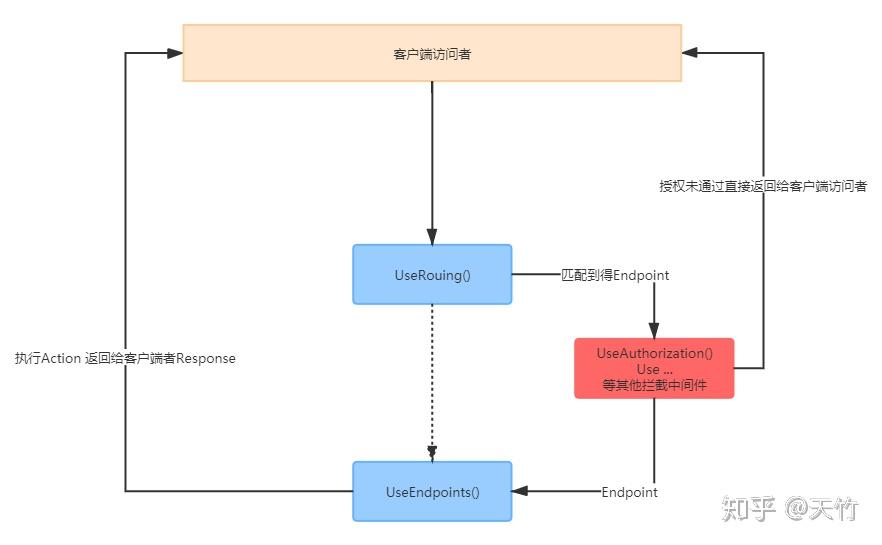|
|
一、背景
在本打算写一篇关于Identityserver4 的文章时候,却发现自己对EndPoint -终结点路由还不是很了解,故暂时先放弃了IdentityServer4 的研究和编写;所以才产生了今天这篇关于EndPoint (终结点路由) 的文章。
还是跟往常一样,打开电脑使用强大的Google 和百度搜索引擎查阅相关资料,以及打开http://Asp.net core 3.1 的源代码进行拜读,同时终于在我的实践及测试中对EndPoint 有了不一样的认识,说到这里更加敬佩微软对Asp.net core 3.x 的框架中管道模型的设计。
我先来提出以下几个问题: 1. 当访问一个Web 应用地址时,http://Asp.Net Core 是怎么执行到Controller 的Action的呢? 2. EndPoint 跟普通路由又存在着什么样的关系? 3. UseRouting() 、UseAuthorization()、UserEndpoints() 这三个中间件的关系是什么呢? 4. 怎么利用EndPoint 终结者路由来拦截Action 的执行并且记录相关操作日志?(时间有限,下一篇文章再来分享整理)
二、拜读源码解惑
Startup 代码
我们先来看一下Startup中简化版的代码,代码如下:
public void ConfigureServices(IServiceCollection services)
{
services.AddControllers();
}
public void Configure(IApplicationBuilder app, IWebHostEnvironment env)
{
app.UseRouting();
app.UseAuthorization();
app.UseEndpoints(endpoints =>
{
endpoints.MapControllers();
});
}程序启动阶段: - 第一步:执行services.AddControllers() 将Controller的核心服务注册到容器中去 - 第二步:执行app.UseRouting() 将EndpointRoutingMiddleware中间件注册到http管道中 - 第三步:执行app.UseAuthorization() 将AuthorizationMiddleware中间件注册到http管道中 - 第四步:执行app.UseEndpoints(encpoints=>endpoints.MapControllers()) 有两个主要的作用: 调用endpoints.MapControllers()将本程序集定义的所有Controller和Action转换为一个个的EndPoint放到路由中间件的配置对象RouteOptions中 将EndpointMiddleware中间件注册到http管道中
app.UseRouting() 源代码如下:
public static IApplicationBuilder UseRouting(this IApplicationBuilder builder)
{
if (builder == null)
{
throw new ArgumentNullException(nameof(builder));
}
VerifyRoutingServicesAreRegistered(builder);
var endpointRouteBuilder = new DefaultEndpointRouteBuilder(builder);
builder.Properties[EndpointRouteBuilder] = endpointRouteBuilder;
return builder.UseMiddleware<EndpointRoutingMiddleware>(endpointRouteBuilder);
}EndpointRoutingMiddleware 中间件代码如下:
internal sealed class EndpointRoutingMiddleware
{
private const string DiagnosticsEndpointMatchedKey = &#34;Microsoft.AspNetCore.Routing.EndpointMatched&#34;;
private readonly MatcherFactory _matcherFactory;
private readonly ILogger _logger;
private readonly EndpointDataSource _endpointDataSource;
private readonly DiagnosticListener _diagnosticListener;
private readonly RequestDelegate _next;
private Task<Matcher> _initializationTask;
public EndpointRoutingMiddleware(
MatcherFactory matcherFactory,
ILogger<EndpointRoutingMiddleware> logger,
IEndpointRouteBuilder endpointRouteBuilder,
DiagnosticListener diagnosticListener,
RequestDelegate next)
{
if (endpointRouteBuilder == null)
{
throw new ArgumentNullException(nameof(endpointRouteBuilder));
}
_matcherFactory = matcherFactory ?? throw new ArgumentNullException(nameof(matcherFactory));
_logger = logger ?? throw new ArgumentNullException(nameof(logger));
_diagnosticListener = diagnosticListener ?? throw new ArgumentNullException(nameof(diagnosticListener));
_next = next ?? throw new ArgumentNullException(nameof(next));
_endpointDataSource = new CompositeEndpointDataSource(endpointRouteBuilder.DataSources);
}
public Task Invoke(HttpContext httpContext)
{
// There&#39;s already an endpoint, skip maching completely
var endpoint = httpContext.GetEndpoint();
if (endpoint != null)
{
Log.MatchSkipped(_logger, endpoint);
return _next(httpContext);
}
// There&#39;s an inherent race condition between waiting for init and accessing the matcher
// this is OK because once `_matcher` is initialized, it will not be set to null again.
var matcherTask = InitializeAsync();
if (!matcherTask.IsCompletedSuccessfully)
{
return AwaitMatcher(this, httpContext, matcherTask);
}
var matchTask = matcherTask.Result.MatchAsync(httpContext);
if (!matchTask.IsCompletedSuccessfully)
{
return AwaitMatch(this, httpContext, matchTask);
}
return SetRoutingAndContinue(httpContext);
// Awaited fallbacks for when the Tasks do not synchronously complete
static async Task AwaitMatcher(EndpointRoutingMiddleware middleware, HttpContext httpContext, Task<Matcher> matcherTask)
{
var matcher = await matcherTask;
await matcher.MatchAsync(httpContext);
await middleware.SetRoutingAndContinue(httpContext);
}
static async Task AwaitMatch(EndpointRoutingMiddleware middleware, HttpContext httpContext, Task matchTask)
{
await matchTask;
await middleware.SetRoutingAndContinue(httpContext);
}
}
[MethodImpl(MethodImplOptions.AggressiveInlining)]
private Task SetRoutingAndContinue(HttpContext httpContext)
{
// If there was no mutation of the endpoint then log failure
var endpoint = httpContext.GetEndpoint();
if (endpoint == null)
{
Log.MatchFailure(_logger);
}
else
{
// Raise an event if the route matched
if (_diagnosticListener.IsEnabled() && _diagnosticListener.IsEnabled(DiagnosticsEndpointMatchedKey))
{
// We&#39;re just going to send the HttpContext since it has all of the relevant information
_diagnosticListener.Write(DiagnosticsEndpointMatchedKey, httpContext);
}
Log.MatchSuccess(_logger, endpoint);
}
return _next(httpContext);
}
// Initialization is async to avoid blocking threads while reflection and things
// of that nature take place.
//
// We&#39;ve seen cases where startup is very slow if we allow multiple threads to race
// while initializing the set of endpoints/routes. Doing CPU intensive work is a
// blocking operation if you have a low core count and enough work to do.
private Task<Matcher> InitializeAsync()
{
var initializationTask = _initializationTask;
if (initializationTask != null)
{
return initializationTask;
}
return InitializeCoreAsync();
}
private Task<Matcher> InitializeCoreAsync()
{
var initialization = new TaskCompletionSource<Matcher>(TaskCreationOptions.RunContinuationsAsynchronously);
var initializationTask = Interlocked.CompareExchange(ref _initializationTask, initialization.Task, null);
if (initializationTask != null)
{
// This thread lost the race, join the existing task.
return initializationTask;
}
// This thread won the race, do the initialization.
try
{
var matcher = _matcherFactory.CreateMatcher(_endpointDataSource);
// Now replace the initialization task with one created with the default execution context.
// This is important because capturing the execution context will leak memory in ASP.NET Core.
using (ExecutionContext.SuppressFlow())
{
_initializationTask = Task.FromResult(matcher);
}
// Complete the task, this will unblock any requests that came in while initializing.
initialization.SetResult(matcher);
return initialization.Task;
}
catch (Exception ex)
{
// Allow initialization to occur again. Since DataSources can change, it&#39;s possible
// for the developer to correct the data causing the failure.
_initializationTask = null;
// Complete the task, this will throw for any requests that came in while initializing.
initialization.SetException(ex);
return initialization.Task;
}
}
private static class Log
{
private static readonly Action<ILogger, string, Exception> _matchSuccess = LoggerMessage.Define<string>(
LogLevel.Debug,
new EventId(1, &#34;MatchSuccess&#34;),
&#34;Request matched endpoint &#39;{EndpointName}&#39;&#34;);
private static readonly Action<ILogger, Exception> _matchFailure = LoggerMessage.Define(
LogLevel.Debug,
new EventId(2, &#34;MatchFailure&#34;),
&#34;Request did not match any endpoints&#34;);
private static readonly Action<ILogger, string, Exception> _matchingSkipped = LoggerMessage.Define<string>(
LogLevel.Debug,
new EventId(3, &#34;MatchingSkipped&#34;),
&#34;Endpoint &#39;{EndpointName}&#39; already set, skipping route matching.&#34;);
public static void MatchSuccess(ILogger logger, Endpoint endpoint)
{
_matchSuccess(logger, endpoint.DisplayName, null);
}
public static void MatchFailure(ILogger logger)
{
_matchFailure(logger, null);
}
public static void MatchSkipped(ILogger logger, Endpoint endpoint)
{
_matchingSkipped(logger, endpoint.DisplayName, null);
}
}
}我们从它的源码中可以看到,EndpointRoutingMiddleware中间件先是创建matcher,然后调用matcher.MatchAsync(httpContext)去寻找Endpoint,最后通过httpContext.GetEndpoint()验证了是否已经匹配到了正确的Endpoint并交个下个中间件继续执行!
app.UseEndpoints() 源代码
public static IApplicationBuilder UseEndpoints(this IApplicationBuilder builder, Action<IEndpointRouteBuilder> configure)
{
if (builder == null)
{
throw new ArgumentNullException(nameof(builder));
}
if (configure == null)
{
throw new ArgumentNullException(nameof(configure));
}
VerifyRoutingServicesAreRegistered(builder);
VerifyEndpointRoutingMiddlewareIsRegistered(builder, out var endpointRouteBuilder);
configure(endpointRouteBuilder);
// Yes, this mutates an IOptions. We&#39;re registering data sources in a global collection which
// can be used for discovery of endpoints or URL generation.
//
// Each middleware gets its own collection of data sources, and all of those data sources also
// get added to a global collection.
var routeOptions = builder.ApplicationServices.GetRequiredService<IOptions<RouteOptions>>();
foreach (var dataSource in endpointRouteBuilder.DataSources)
{
routeOptions.Value.EndpointDataSources.Add(dataSource);
}
return builder.UseMiddleware<EndpointMiddleware>();
}
internal class DefaultEndpointRouteBuilder : IEndpointRouteBuilder
{
public DefaultEndpointRouteBuilder(IApplicationBuilder applicationBuilder)
{
ApplicationBuilder = applicationBuilder ?? throw new ArgumentNullException(nameof(applicationBuilder));
DataSources = new List<EndpointDataSource>();
}
public IApplicationBuilder ApplicationBuilder { get; }
public IApplicationBuilder CreateApplicationBuilder() => ApplicationBuilder.New();
public ICollection<EndpointDataSource> DataSources { get; }
public IServiceProvider ServiceProvider => ApplicationBuilder.ApplicationServices;
}代码中构建了DefaultEndpointRouteBuilder 终结点路由构建者对象,该对象中存储了Endpoint的集合数据;同时把终结者路由集合数据存储在了routeOptions 中,并注册了EndpointMiddleware 中间件到http管道中; Endpoint对象代码如下:
/// <summary>
/// Represents a logical endpoint in an application.
/// </summary>
public class Endpoint
{
/// <summary>
/// Creates a new instance of <see cref=&#34;Endpoint&#34;/>.
/// </summary>
/// <param name=&#34;requestDelegate&#34;>The delegate used to process requests for the endpoint.</param>
/// <param name=&#34;metadata&#34;>
/// The endpoint <see cref=&#34;EndpointMetadataCollection&#34;/>. May be null.
/// </param>
/// <param name=&#34;displayName&#34;>
/// The informational display name of the endpoint. May be null.
/// </param>
public Endpoint(
RequestDelegate requestDelegate,
EndpointMetadataCollection metadata,
string displayName)
{
// All are allowed to be null
RequestDelegate = requestDelegate;
Metadata = metadata ?? EndpointMetadataCollection.Empty;
DisplayName = displayName;
}
/// <summary>
/// Gets the informational display name of this endpoint.
/// </summary>
public string DisplayName { get; }
/// <summary>
/// Gets the collection of metadata associated with this endpoint.
/// </summary>
public EndpointMetadataCollection Metadata { get; }
/// <summary>
/// Gets the delegate used to process requests for the endpoint.
/// </summary>
public RequestDelegate RequestDelegate { get; }
public override string ToString() => DisplayName ?? base.ToString();
}Endpoint 对象代码中有两个关键类型属性分别是EndpointMetadataCollection 类型和RequestDelegate: - EndpointMetadataCollection:存储了Controller 和Action相关的元素集合,包含Action 上的Attribute 特性数据等 - RequestDelegate :存储了Action 也即委托,这里是每一个Controller 的Action 方法
再回过头来看看EndpointMiddleware 中间件和核心代码,EndpointMiddleware 的一大核心代码主要是执行Endpoint 的RequestDelegate 委托,也即Controller 中的Action 的执行。
public Task Invoke(HttpContext httpContext)
{
var endpoint = httpContext.GetEndpoint();
if (endpoint?.RequestDelegate != null)
{
if (!_routeOptions.SuppressCheckForUnhandledSecurityMetadata)
{
if (endpoint.Metadata.GetMetadata<IAuthorizeData>() != null &&
!httpContext.Items.ContainsKey(AuthorizationMiddlewareInvokedKey))
{
ThrowMissingAuthMiddlewareException(endpoint);
}
if (endpoint.Metadata.GetMetadata<ICorsMetadata>() != null &&
!httpContext.Items.ContainsKey(CorsMiddlewareInvokedKey))
{
ThrowMissingCorsMiddlewareException(endpoint);
}
}
Log.ExecutingEndpoint(_logger, endpoint);
try
{
var requestTask = endpoint.RequestDelegate(httpContext);
if (!requestTask.IsCompletedSuccessfully)
{
return AwaitRequestTask(endpoint, requestTask, _logger);
}
}
catch (Exception exception)
{
Log.ExecutedEndpoint(_logger, endpoint);
return Task.FromException(exception);
}
Log.ExecutedEndpoint(_logger, endpoint);
return Task.CompletedTask;
}
return _next(httpContext);
static async Task AwaitRequestTask(Endpoint endpoint, Task requestTask, ILogger logger)
{
try
{
await requestTask;
}
finally
{
Log.ExecutedEndpoint(logger, endpoint);
}
}
}疑惑解答:
1. 当访问一个Web 应用地址时,http://Asp.Net Core 是怎么执行到Controller 的Action的呢?
答:程序启动的时候会把所有的Controller 中的Action 映射存储到routeOptions 的集合中,Action 映射成Endpoint终结者 的RequestDelegate 委托属性,最后通过UseEndPoints 添加EndpointMiddleware 中间件进行执行,同时这个中间件中的Endpoint 终结者路由已经是通过Routing匹配后的路由。
2. EndPoint 跟普通路由又存在着什么样的关系?
答:Ednpoint 终结者路由是普通路由map 转换后的委托路由,里面包含了路由方法的所有元素信息EndpointMetadataCollection 和RequestDelegate 委托。
3. UseRouting() 、UseAuthorization()、UseEndpoints() 这三个中间件的关系是什么呢?
答:UseRouing 中间件主要是路由匹配,找到匹配的终结者路由Endpoint ;UseEndpoints 中间件主要针对UseRouting 中间件匹配到的路由进行 委托方法的执行等操作。 UseAuthorization 中间件主要针对 UseRouting 中间件中匹配到的路由进行拦截 做授权验证操作等,通过则执行下一个中间件UseEndpoints(),具体的关系可以看下面的流程图:

上面流程图中省略了一些部分,主要是把UseRouting 、UseAuthorization 、UseEndpoint 这三个中间件的关系突显出来。
最后我们可以在UseRouting() 和UseEndpoint() 注册的Http 管道之间 注册其他牛逼的自定义中间件,以实现我们自己都有的业务逻辑
以上如果有错误的地方,请大家积极纠正,谢谢大家的支持!!
欢迎微信扫码关注【dotNET博士】微信公众号。
 |
|